|
|
|
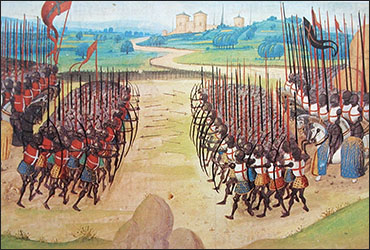

BATTLE OF AGINCOURT (October 25, 1415)
The English army had been for a month investing Harfleur before the French government was roused from its inactivity.
On the 10th of September, the king of France [Charles VI] took the Oriflamme at St. Denis,
and departed for Normandy. He had arrived at Rouen with his son, when the news of the fall of Harfleur reached the court.
He was soon surrounded by princes and great lords with their men-at-arms. It was known that the constable of France was
watching the passages of the Somme; and that the English, in ascending the left bank, were sustaining great privations.
The weather was wet and tempestuous. The princes and nobles believed they had now nothing to dread from the presumption
of king Henry.
The citizens of Paris offered to send six thousand men well armed. The old duke
de Berri, who had fought at Poitiers sixty years before, urged the acceptance of the offer.
The duke of Alençon and the young chivalry would have nothing to do with these common people—"What do we
want of these shopkeepers? We have already three times the number of the English." The princes sent to Henry three
officers of arms, to tell him that, being resolved to fight him, they desired him to name a day and a place for the
battle. The king of England replied that, having set out from his town of Harfleur, he was on his way to England; and
that, resting in no town or fortress, they might find him any day and hour in the open field.*
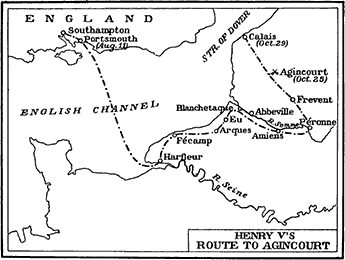
Onward marched Henry by Peronne, the roads being found trodden "as if the French had gone before him in many thousands."
On the 24th,—the fourth day after they had crossed the Somme,—the English army arrived at Blangy, in perfect
discipline. A branch of the Canche, the Ternoise, was here crossed without difficulty. The French army was on the rising
ground about a league distant. From Blangy there is a gentle ascent towards the village of Maisoncelles. "When we reached
the top of the hill," says the priest,1 "we saw three columns of the French emerge from the upper part of the valley, about
a mile from us; who at length being formed into battalions, companies, and troops, in multitudes compared with us, halted
a little more than half a mile opposite to us, filling a very wide field, as if with an innumerable host of locusts,—a
moderate sized valley being betwixt us and them"—the plain of Agincourt.
When Henry had crossed the river and ascended the hill, he expected instant battle. He formed his troops, and went about
exhorting them to do their duty. Walter Hungerford, according to our good priest's account, regretted that they had not
with them ten thousand English archers. The solemn answer of the king, relying upon God for victory, has been given by
the priest.2 Other burning words,—the version of the poet3—have superseded the dialogue
of the chroniclers. The sun was setting; and there was no attack. At Maisoncelles, about a mile and a half from Blangy,
the king took up his quarters for the night. In the gloomy twilight "a white way" had been found to this village. The
noise of the French was heard as they took up their quarters, each vociferating for his servant or his comrade. Henry
commanded the strictest silence. It was a night of dread to those who knew how many thousand enemies were close at hand.
There was little sleep. The armourers were at work; the priests were confessing their penitents. In the French camp the
confident knights played at dice, the stakes being the ransoms of their expected prisoners.
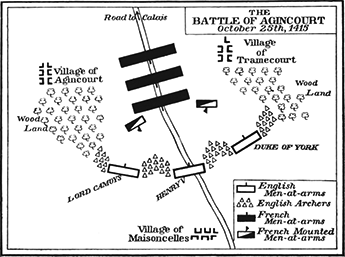
The route to Calais lay through the plain of Agincourt. The village of Maisoncelles is about a mile from this field.
Henry rose with the dawn on that 25th of October, the feast of St. Crispin; and he heard three masses. He was fully armed;
and he wore a crown on his head of extraordinary magnificence. He mounted a small gray horse, and drew up his men upon
the open ground near Maisoncelles, then covered with young corn. His little band was formed in one line, the men-at-arms
in the centre, with wings on the left and right, the archers being posted between the wings, with their stakes fixed
before them. A party that went into the village of Agincourt found no armed men there. Another party of archers were
concealed in the village of Tramecourt.
The French army was in three lines, completely covering the route to Calais. The advanced guard of about eight thousand
knights and esquires, and five thousand five hundred archers and cross-bowmen, was composed of the greater part of the
French nobility. The main body was crowded in prodigious numbers, the lines, according to the lowest estimate, being
twenty men in depth. The men-at-arms wore coats of steel reaching to their knees, and heavy leg-armour, with other
encumbering panoply. The contemporary chroniclers, both French and English, differ greatly as to the number of the French
army. The lowest estimate is fifty thousand fighting men; the highest, one hundred and fifty thousand. The probability is
that they were ten times as many as the English. Their position was between the two woods of Agincourt and Tramecourt,
in a space much too confined for the movements of such a vast body... the position was a disadvantageous one.
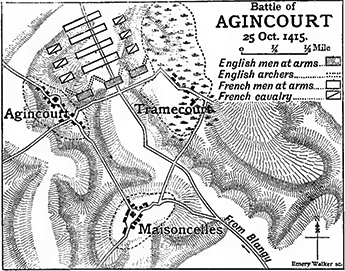
The two armies passed several hours without a movement on either side. According to Monstrelet, Sir Thomas Erpingham,
a knight grown gray with age and honour, at last flung his truncheon in the air, and called "Nestrocque!" ("now strike!")
and then dismounted, as the king and others had done. The English then knelt down, invoking the protection of God;
and each man put a small piece of earth into his mouth, in remembrance that they were formed of dust, and to dust
should return. Shouting the national "hurrah!" they kept advancing. The archers, without armour, in jackets and loose
hose, some even barefoot, went boldly on to meet the mailed chivalry. Their bow-strings were drawn. The French stooped
as the deadly shafts flew amongst them. Many were slain. Onward rushed the thousands of horsemen to break the line of
the hardy yeomen. The sharpened stakes were planted in the earth; and the archers shrank not from the charge. The arrows
again flew; and the horses becoming unmanageable from their wounds, the knights were driven back upon the van, which they
threw into confusion. The king now advanced with his main body. A deadly conflict ensued. The archers threw away their
bows, and fought with sword and bill.
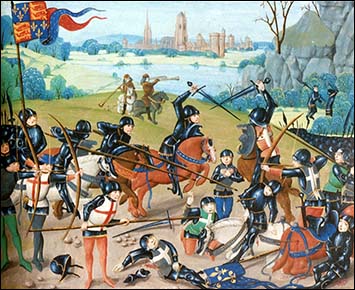
The second French line was soon reached; and here again the contest became more a slaughter than a battle. The enormous
numbers of the French were the chief cause of their destruction. Their heavy armour was an incumbrance instead of a
defence. The rear division, after the overthrow of the first and second division, took to flight. In three hours this
terrible fight was over. The priest, who was "sitting on horseback among the baggage, in the rear of the battle," thus
describes the slaughter of the French on this day of Agincourt: "When some of them in the engagement had been killed,
and fell in the front, so great was the undisciplined violence and pressure of the multitude behind, that the living
fell over the dead, and others also, falling on the living, were slain; so that, in three places, where the force and
host of our standards were, so great grew the heap of the slain, and of those who were overthrown among them, that our
people ascended the very heaps, which had increased higher than a man, and butchered the adversaries below with swords,
axes, and other weapons. And when at length, in two or three hours, that front battle was perforated and broken up,
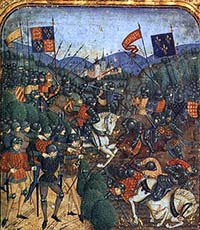 and the rest were driven to flight, our men began to pull down the heaps, and to separate the living from the dead,
proposing to keep the living as slaves, to be ransomed." Few were left alive for ransom.
and the rest were driven to flight, our men began to pull down the heaps, and to separate the living from the dead,
proposing to keep the living as slaves, to be ransomed." Few were left alive for ransom.
A clamour arose that the French, collecting in various parts of the field, were coming upon the wearied victors. The
baggage, according to Monstrelet, was being plundered. In the momentary alarm, Henry commanded a massacre of all the
prisoners. The French chroniclers mention this horrible circumstance in terms of sorrow rather than of blame. The hasty
instinct of self-preservation dictated the order. The day before the battle the king had discharged, upon their parole,
all the prisoners he had brought with him. His nature was not cruel. He stopped the carnage when he found that the danger
was imaginary.
On the part of the English, the duke of York and the earl of Oxford4 were slain,
with some hundreds of inferior degree. The estimates of this loss are very conflicting. Our own chronicles make it absurdly
small. Monstrelet says the loss of the English was sixteen hundred; and so St. Remy, another French historian. Of the
chivalry of France, the flower perished. Seven of the princes of the blood had fallen. With the duke of Alençon Henry
had fought in person, and was beaten down, having a portion of his crown struck off. The king could not save his gallant
enemy, who fell before Henry's guards. Eight thousand gentlemen of France perished in that field of carnage, of whom a
hundred and twenty were nobles bearing banners.
The herald of France was taken in the battle. "Montjoie," said Henry, "to whom is the victory—to me or to the king
of France?" "To you, and not to him," said Montjoie. "And how is this castle called?" "The castle of Agincourt." "Well,"
said the king, "they will long speak of the battle of Agincourt." They will speak of it, as long as England's history
endures, as one of the most wonderful examples of bravery, and fortitude, and heroic daring, of which a people may be
justly proud. But they will also speak of it as a fearful sacrifice of human life to a false ambition, which had no
object beyond the assertion of an indomitable will, and no permanent results beyond the perpetuation of hatred and
jealousy between nation and nation.
* See Barante, tom. iii.
[AJ Notes:
1. An anonymous priest who was present at Agincourt, who subsequently wrote the Gesta Henrici Quinti, the earliest
chronicle of Henry's French campaigns.
2. From the Gesta Henrici Quinti: "'That is a foolish way to talk', the king said to him, 'because, by the God in
Heaven upon Whose grace I have relied and in Whom is my firm hope of victory, I would not, even if I could, have a single
man more than I do. For these I have here with me are God's people, whom He deigns to let me have at this time.'"
3. See Shakespeare's Henry V, the St. Crispin's Day speech.
4. This is incorrect. Richard de Vere, earl of Oxford, survived Agincourt and lived another 2 years, dying in 1417.
The author perhaps confused him with the Earl of Suffolk, who did perish at Agincourt.]
Excerpted from:
Knight, Charles. The Popular History of England. Vol II.
London: Bradbury and Evans, 1857. 60-64.
Other Local Resources:
Books for further study:
Allmand, Christopher. The Hundred Years War: England and France at War.
Cambridge University Press, 2005.
Barker, Juliet. Agincourt: Henry V and the Battle That Made England.
Back Bay Books; Repr. Ed. 2007.
Curry, Anne, and Malcolm Mercer, eds. The Battle of Agincourt: The Illustrated Companion.
Yale University Press; Repr. ed., 2017.
Mortimer, Ian. 1415: Henry V's Year of Glory.
Vintage Books; 2013.
Seward, Desmond. The Hundred Years War: The English in France 1337-1453.
Penguin, 1999.
The Battle of Agincourt on the Web:
 | to Luminarium Encyclopedia |
Site ©1996-2023 Anniina Jokinen. All rights reserved.
This page was created on January 1, 2018. Last updated March 1, 2023.
|
Index of Encyclopedia Entries:
Medieval Cosmology
Prices of Items in Medieval England
Edward II
Isabella of France, Queen of England
Piers Gaveston
Thomas of Brotherton, E. of Norfolk
Edmund of Woodstock, E. of Kent
Thomas, Earl of Lancaster
Henry of Lancaster, Earl of Lancaster
Henry of Grosmont, Duke of Lancaster
Roger Mortimer, Earl of March
Hugh le Despenser the Younger
Bartholomew, Lord Burghersh, elder
Hundred Years' War (1337-1453)
Edward III
Philippa of Hainault, Queen of England
Edward, Black Prince of Wales
John of Eltham, Earl of Cornwall
The Battle of Crécy, 1346
The Siege of Calais, 1346-7
The Battle of Poitiers, 1356
Lionel of Antwerp, Duke of Clarence
John of Gaunt, Duke of Lancaster
Edmund of Langley, Duke of York
Thomas of Woodstock, Gloucester
Richard of York, E. of Cambridge
Richard Fitzalan, 3. Earl of Arundel
Roger Mortimer, 2nd Earl of March
The Good Parliament, 1376
Richard II
The Peasants' Revolt, 1381
Lords Appellant, 1388
Richard Fitzalan, 4. Earl of Arundel
Archbishop Thomas Arundel
Thomas de Beauchamp, E. Warwick
Robert de Vere, Earl of Oxford
Ralph Neville, E. of Westmorland
Thomas Mowbray, Duke of Norfolk
Edmund Mortimer, 3. Earl of March
Roger Mortimer, 4. Earl of March
John Holland, Duke of Exeter
Michael de la Pole, E. Suffolk
Hugh de Stafford, 2. E. Stafford
Henry IV
Edward, Duke of York
Edmund Mortimer, 5. Earl of March
Henry Percy, Earl of Northumberland
Sir Henry Percy, "Harry Hotspur"
Thomas Percy, Earl of Worcester
Owen Glendower
The Battle of Shrewsbury, 1403
Archbishop Richard Scrope
Thomas Mowbray, 3. E. Nottingham
John Mowbray, 2. Duke of Norfolk
Thomas Fitzalan, 5. Earl of Arundel
Henry V
Thomas, Duke of Clarence
John, Duke of Bedford
Humphrey, Duke of Gloucester
John Talbot, Earl of Shrewsbury
Richard, Earl of Cambridge
Henry, Baron Scrope of Masham
William de la Pole, Duke of Suffolk
Thomas Montacute, E. Salisbury
Richard Beauchamp, E. of Warwick
Henry Beauchamp, Duke of Warwick
Thomas Beaufort, Duke of Exeter
Cardinal Henry Beaufort
John Beaufort, Earl of Somerset
Sir John Fastolf
John Holland, 2. Duke of Exeter
Archbishop John Stafford
Archbishop John Kemp
Catherine of Valois
Owen Tudor
John Fitzalan, 7. Earl of Arundel
John, Lord Tiptoft
Charles VII, King of France
Joan of Arc
Louis XI, King of France
Charles the Bold, Duke of Burgundy
The Battle of Agincourt, 1415
The Battle of Castillon, 1453
The Wars of the Roses 1455-1485
Causes of the Wars of the Roses
The House of Lancaster
The House of York
The House of Beaufort
The House of Neville
The First Battle of St. Albans, 1455
The Battle of Blore Heath, 1459
The Rout of Ludford, 1459
The Battle of Northampton, 1460
The Battle of Wakefield, 1460
The Battle of Mortimer's Cross, 1461
The 2nd Battle of St. Albans, 1461
The Battle of Towton, 1461
The Battle of Hedgeley Moor, 1464
The Battle of Hexham, 1464
The Battle of Edgecote, 1469
The Battle of Losecoat Field, 1470
The Battle of Barnet, 1471
The Battle of Tewkesbury, 1471
The Treaty of Pecquigny, 1475
The Battle of Bosworth Field, 1485
The Battle of Stoke Field, 1487
Henry VI
Margaret of Anjou
Richard Plantagenet, Duke of York
Edward IV
Elizabeth Woodville
Richard Woodville, 1. Earl Rivers
Anthony Woodville, 2. Earl Rivers
Jane Shore
Edward V
Richard III
George, Duke of Clarence
Ralph Neville, 2. Earl of Westmorland
Richard Neville, Earl of Salisbury
Richard Neville, Earl of Warwick
Edward Neville, Baron Bergavenny
William Neville, Lord Fauconberg
Robert Neville, Bishop of Salisbury
John Neville, Marquis of Montagu
George Neville, Archbishop of York
John Beaufort, 1. Duke Somerset
Edmund Beaufort, 2. Duke Somerset
Henry Beaufort, 3. Duke of Somerset
Edmund Beaufort, 4. Duke Somerset
Margaret Beaufort
Edmund Tudor, Earl of Richmond
Jasper Tudor, Earl of Pembroke
Humphrey Stafford, D. Buckingham
Henry Stafford, Duke of Buckingham
Humphrey Stafford, E. of Devon
Thomas, Lord Stanley, Earl of Derby
Sir William Stanley
Archbishop Thomas Bourchier
Henry Bourchier, Earl of Essex
John Mowbray, 3. Duke of Norfolk
John Mowbray, 4. Duke of Norfolk
John Howard, Duke of Norfolk
Henry Percy, 2. E. Northumberland
Henry Percy, 3. E. Northumberland
Henry Percy, 4. E. Northumberland
William, Lord Hastings
Henry Holland, Duke of Exeter
William Fitzalan, Earl of Arundel
William Herbert, 1. Earl of Pembroke
John de Vere, 12th Earl of Oxford
John de Vere, 13th Earl of Oxford
Thomas de Clifford, 8. Baron Clifford
John de Clifford, 9. Baron Clifford
John Tiptoft, Earl of Worcester
Thomas Grey, 1. Marquis Dorset
Sir Andrew Trollop
Archbishop John Morton
Edward Plantagenet, E. of Warwick
John Talbot, 2. E. Shrewsbury
John Talbot, 3. E. Shrewsbury
John de la Pole, 2. Duke of Suffolk
John de la Pole, E. of Lincoln
Edmund de la Pole, E. of Suffolk
Richard de la Pole
John Sutton, Baron Dudley
James Butler, 5. Earl of Ormonde
Sir James Tyrell
Edmund Grey, first Earl of Kent
George Grey, 2nd Earl of Kent
John, 5th Baron Scrope of Bolton
James Touchet, 7th Baron Audley
Walter Blount, Lord Mountjoy
Robert Hungerford, Lord Moleyns
Thomas, Lord Scales
John, Lord Lovel and Holand
Francis Lovell, Viscount Lovell
Sir Richard Ratcliffe
William Catesby
Ralph, 4th Lord Cromwell
Jack Cade's Rebellion, 1450
Tudor Period
King Henry VII
Queen Elizabeth of York
Arthur, Prince of Wales
Lambert Simnel
Perkin Warbeck
The Battle of Blackheath, 1497
King Ferdinand II of Aragon
Queen Isabella of Castile
Maximilian I, Holy Roman Emperor
King Henry VIII
Queen Catherine of Aragon
Queen Anne Boleyn
Queen Jane Seymour
Queen Anne of Cleves
Queen Catherine Howard
Queen Katherine Parr
King Edward VI
Queen Mary I
Queen Elizabeth I
Henry Fitzroy, Duke of Richmond
Margaret Tudor, Queen of Scotland
James IV, King of Scotland
The Battle of Flodden Field, 1513
James V, King of Scotland
Mary of Guise, Queen of Scotland
Mary Tudor, Queen of France
Louis XII, King of France
Francis I, King of France
The Battle of the Spurs, 1513
Field of the Cloth of Gold, 1520
Charles V, Holy Roman Emperor
Eustace Chapuys, Imperial Ambassador
The Siege of Boulogne, 1544
Cardinal Thomas Wolsey
Archbishop Thomas Cranmer
Thomas Cromwell, Earl of Essex
Thomas, Lord Audley
Thomas Wriothesley, E. Southampton
Sir Richard Rich
Edward Stafford, D. of Buckingham
Thomas Howard, 2nd Duke of Norfolk
Thomas Howard, 3rd Duke of Norfolk
John Dudley, Duke of Northumberland
Charles Brandon, Duke of Suffolk
Thomas Boleyn, Earl of Wiltshire
George Boleyn, Viscount Rochford
John Russell, Earl of Bedford
Thomas Grey, 2. Marquis of Dorset
Henry Grey, D. of Suffolk
Charles Somerset, Earl of Worcester
George Talbot, 4. E. Shrewsbury
Francis Talbot, 5. E. Shrewsbury
Henry Algernon Percy,
5th Earl of Northumberland
Henry Algernon Percy,
6th Earl of Northumberland
Ralph Neville, 4. E. Westmorland
Henry Neville, 5. E. Westmorland
William Paulet, Marquis of Winchester
Sir Francis Bryan
Sir Nicholas Carew
John de Vere, 15th Earl of Oxford
John de Vere, 16th Earl of Oxford
Thomas Seymour, Lord Admiral
Edward Seymour, Protector Somerset
Margaret Pole, Countess of Salisbury
Henry Pole, Lord Montague
Sir Geoffrey Pole
Thomas Manners, Earl of Rutland
Henry Manners, Earl of Rutland
Henry Bourchier, 2. Earl of Essex
Robert Radcliffe, 1. Earl of Sussex
Henry Radcliffe, 2. Earl of Sussex
George Hastings, Earl of Huntingdon
Henry Courtenay, Marquis of Exeter
George Neville, Baron Bergavenny
Sir Edward Neville
William, Lord Paget
William Sandys, Baron Sandys
William Fitzwilliam, E. Southampton
Sir Anthony Browne
Sir Thomas Wriothesley
Sir William Kingston
George Brooke, Lord Cobham
Sir Richard Southwell
Thomas Fiennes, 9th Lord Dacre
Sir Francis Weston
Henry Norris
Lady Jane Grey
Sir Thomas Arundel
Sir Richard Sackville
Sir William Petre
Sir John Cheke
Walter Haddon, L.L.D
Sir Peter Carew
Sir John Mason
Nicholas Wotton
John Taylor
Sir Thomas Wyatt, the Younger
Cardinal Lorenzo Campeggio
Cardinal Reginald Pole
Stephen Gardiner, Bishop of Winchester
Edmund Bonner, Bishop of London
Nicholas Ridley, Bishop of London
John Hooper, Bishop of Gloucester
John Aylmer, Bishop of London
Thomas Linacre
William Grocyn
Archbishop William Warham
Cuthbert Tunstall, Bishop of Durham
Richard Fox, Bishop of Winchester
Edward Fox, Bishop of Hereford
Pope Julius II
Pope Leo X
Pope Clement VII
Pope Paul III
Pope Pius V
Pico della Mirandola
Desiderius Erasmus
Martin Bucer
Richard Pace
Christopher Saint-German
Thomas Tallis
Elizabeth Barton, the Nun of Kent
Hans Holbein, the Younger
The Sweating Sickness
Dissolution of the Monasteries
Pilgrimage of Grace, 1536
Robert Aske
Anne Askew
Lord Thomas Darcy
Sir Robert Constable
Oath of Supremacy
The Act of Supremacy, 1534
The First Act of Succession, 1534
The Third Act of Succession, 1544
The Ten Articles, 1536
The Six Articles, 1539
The Second Statute of Repeal, 1555
The Act of Supremacy, 1559
Articles Touching Preachers, 1583
Queen Elizabeth I
William Cecil, Lord Burghley
Robert Cecil, 1st Earl of Salisbury
Sir Francis Walsingham
Sir Nicholas Bacon
Sir Thomas Bromley
Robert Dudley, Earl of Leicester
Ambrose Dudley, Earl of Warwick
Henry Carey, Lord Hunsdon
Sir Thomas Egerton, Viscount Brackley
Sir Francis Knollys
Katherine "Kat" Ashley
Lettice Knollys, Countess of Leicester
George Talbot, 6. E. of Shrewsbury
Elizabeth, Countess of Shrewsbury
Gilbert Talbot, 7. E. of Shrewsbury
Sir Henry Sidney
Sir Robert Sidney
Archbishop Matthew Parker
Walter Devereux, 1st Earl of Essex
Robert Devereux, 2nd Earl of Essex
Penelope Devereux, Lady Rich
Sir Christopher Hatton
Edward Courtenay, E. Devonshire
Edward Manners, 3rd Earl of Rutland
Thomas Radcliffe, 3. Earl of Sussex
Henry Radcliffe, 4. Earl of Sussex
Robert Radcliffe, 5. Earl of Sussex
William Parr, Marquis of Northampton
Henry Wriothesley, 2. Southampton
Henry Wriothesley, 3. Southampton
Charles Neville, 6. E. Westmorland
Thomas Percy, 7. E. Northumberland
Henry Percy, 8. E. Northumberland
Henry Percy, 9. E. Nothumberland
William Herbert, 1. Earl of Pembroke
Charles, Lord Howard of Effingham
Thomas Howard, 4th Duke of Norfolk
Henry Howard, 1. Earl of Northampton
Thomas Howard, 1. Earl of Suffolk
Henry Hastings, 3. E. of Huntingdon
Edward Manners, 3rd Earl of Rutland
Roger Manners, 5th Earl of Rutland
Francis Manners, 6th Earl of Rutland
Henry FitzAlan, 12. Earl of Arundel
Thomas, Earl Arundell of Wardour
Edward Somerset, E. of Worcester
William Davison
Sir Walter Mildmay
Sir Ralph Sadler
Sir Amyas Paulet
Gilbert Gifford
Anthony Browne, Viscount Montague
François, Duke of Alençon & Anjou
Mary, Queen of Scots
Henry Stuart, Lord Darnley
James Hepburn, Earl of Bothwell
Anthony Babington and the Babington Plot
John Knox
Philip II of Spain
The Spanish Armada, 1588
Sir Francis Drake
Sir John Hawkins
William Camden
Archbishop Whitgift
Martin Marprelate Controversy
John Penry (Martin Marprelate)
Richard Bancroft, Archbishop of Canterbury
John Dee, Alchemist
Philip Henslowe
Edward Alleyn
The Blackfriars Theatre
The Fortune Theatre
The Rose Theatre
The Swan Theatre
Children's Companies
The Admiral's Men
The Lord Chamberlain's Men
Citizen Comedy
The Isle of Dogs, 1597
Common Law
Court of Common Pleas
Court of King's Bench
Court of Star Chamber
Council of the North
Fleet Prison
Assize
Attainder
First Fruits & Tenths
Livery and Maintenance
Oyer and terminer
Praemunire
The Stuarts
King James I of England
Anne of Denmark
Henry, Prince of Wales
The Gunpowder Plot, 1605
George Villiers, 1st Duke of Buckingham
Robert Carr, Earl of Somerset
Arabella Stuart, Lady Lennox
William Alabaster
Bishop Hall
Bishop Thomas Morton
Archbishop William Laud
John Selden
Lucy Harington, Countess of Bedford
Henry Lawes
King Charles I
Queen Henrietta Maria
Long Parliament
Rump Parliament
Kentish Petition, 1642
Thomas Wentworth, Earl of Strafford
John Digby, Earl of Bristol
George Digby, 2nd Earl of Bristol
Thomas Fairfax, 3rd Lord Fairfax
Robert Devereux, 3rd E. of Essex
Robert Sidney, 2. E. of Leicester
Algernon Percy, E. of Northumberland
Henry Montagu, Earl of Manchester
Edward Montagu, 2. Earl of Manchester
The Restoration
King Charles II
King James II
Test Acts
Greenwich Palace
Hatfield House
Richmond Palace
Windsor Palace
Woodstock Manor
The Cinque Ports
Mermaid Tavern
Malmsey Wine
Great Fire of London, 1666
Merchant Taylors' School
Westminster School
The Sanctuary at Westminster
"Sanctuary"
Images:
Chart of the English Succession from William I through Henry VII
Medieval English Drama
London c1480, MS Royal 16
London, 1510, the earliest view in print
Map of England from Saxton's Descriptio Angliae, 1579
London in late 16th century
Location Map of Elizabethan London
Plan of the Bankside, Southwark, in Shakespeare's time
Detail of Norden's Map of the Bankside, 1593
Bull and Bear Baiting Rings from the Agas Map (1569-1590, pub. 1631)
Sketch of the Swan Theatre, c. 1596
Westminster in the Seventeenth Century, by Hollar
Visscher's View of London, 1616
Larger Visscher's View in Sections
c. 1690. View of London Churches, after the Great Fire
The Yard of the Tabard Inn from Thornbury, Old and New London
|
|